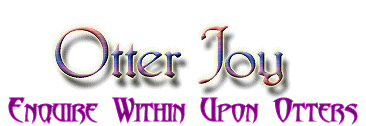Social Behaviour of the Smooth-Coated Otter
Territory
Smooth Otters require quite large territories, being large animals living in family groups. Exact territory size would depend on the type and richness of an area. There is some evidence that if a territory is rich enough, family groups will share some parts of their territory with adjacent groups. In Malaysia, feeding territories are around 7 - 12 sq km ( Wayre in IUCN, 1977). Coastal territories will also include a source of fresh water for drinking and coat maintenance.
Holt
Smooth otters dig large burrows, with one or more nest chambers above the high water mark, and a narrow entrance tunnel, sometimes debouching below water level. Presumably in this case, there is another entrance above water level for the cubs to use. Mother otters with cubs do not allow any other animal to enter the holt, so presumably the rest of the group either sleep in other chambers, or in shallow burrows, piles of driftwood or rock crevices nearby.
Daily Activity
The otters hunt by day and night. In the wild, they appear to have hunting sessions of about an hour, interspersed with rest periods on the bank or in the holt.
Sociability
A monogamous alpha pair form a fairly stable family group containing cubs of previous years. The alpha female is dominant over all other animals in the group; mature females have been seen to fight with the alpha female (Yadav (1967)), and it is possible that in the wild, females leave to form new groups. The alpha female regulates the group heirarchy by ritualized aggression, but this is rarely seen, unless an outsider joins the group or there is a serious challenge from within the group; it is, however, the alpha male that initiates group movement through the territory, and forays in other groups' feeding ranges, along with any resultant conflict ( Duplaix-Hall, 1972).| Smooth-Coated Otter |

